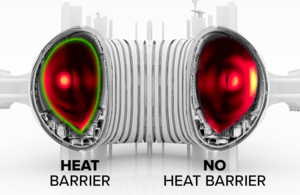 Experiments conducted at the United Kingdom Atomic Energy Authority’s (UKAEA’s) Joint European Torus (JET) in Culham have managed to achieve “clean” plasma by creating a heat barrier.
Experiments conducted at the United Kingdom Atomic Energy Authority’s (UKAEA’s) Joint European Torus (JET) in Culham have managed to achieve “clean” plasma by creating a heat barrier.
To withstand the intense heat produced during the fusion process, metals with a high melting point have to be used in the tokamak’s inner walls, such as tungsten. However, tungsten can contaminate and dilute the plasma when the hot plasma interacts with the machine’s walls. The impurities created can excessively cool the plasma by absorbing heat, which is then lost from the plasma in the form of light. This reduces power from fusion reactions within the plasma.
Scientists from EUROfusion and UKAEA have found that by creating a particular type of “heat barrier” the tungsten contaminants are prevented from entering the core of plasma. This resembles a thin skin on the outside of the plasma, in the form of a large temperature drop of 20m degrees Celsius. This method of maintaining “clean” plasma was just hypothetical before being demonstrated at JET. The method was trialled as part of a series of experiments that contributed to JET breaking the world-record in sustained fusion energy in 2022.
“Our measurements showed that we are one step closer to solving one of the greatest scientific quests of our time,” said Dr Anthony Field, senior fusion researcher at UKAEA. “The plasma can keep itself clear of tungsten contaminants that would cool it, by maintaining a temperature drop of 20m degrees Celsius at the edge of our plasma. This prevents the tungsten ions from stopping us reaching fusion conditions.”
The results will support work at the International Thermonuclear Experimental Reactor (ITER) under construction at Saint-Paul-les-Durance in southern France. Dr Joëlle Mailloux, JET task force leader, said this was “a key result that was predicted by theory, which we’ve never observed before”. She explained: “Under the right conditions, we can have our plasma expel the metallic impurities to its very edge, so they don’t cool the confined plasma where fusion takes place. This is a crucial ingredient for sustained high fusion performance in ITER.”
Dr Alberto Loarte, head of ITER’s Science Division said the results confirm a long-standing prediction that high-performance plasmas required for fusion power production can shield themselves very effectively from tungsten impurities coming from the wall. “This was very challenging to demonstrate experimentally, because you need to approach ITER-like conditions in smaller, present-day tokamaks. The JET scientists have gotten close enough to ITER conditions to see this new effect at play. This provides a robust basis for our predictions for how ITER plasmas will behave.”
According to Dr Athina Kappatou, scientific co-ordinator of JET experiments from Germany’s Max-Planck Institute for Plasma Physics: “We were aware that theory predicted how ITER plasmas could use a steep temperature drop to keep these impurities out, but this had not yet been demonstrated in a current device. It was very exciting to see that we could approach ITER conditions close enough to demonstrate this effect in JET plasmas and benefit from it in our quest for high fusion performance.”
In February 2022, JET demonstrated a record-breaking 59 megajoules of sustained fusion energy. This was achieved by the EUROfusion consortium of experts, students and staff from across Europe, co-funded by the European Commission. In-depth analyses of the results from the series of experiments conducted when JET achieve this record will be released at the International Atomic Energy Agency’s Fusion Energy Conference in October.
Image: A ‘heat barrier’ prevents tungsten from contaminating the plasma (courtesy of UKAEA)






